BSBMGT516 - Facilitate Continuous Improvement Assignment Solution
VerifiedAdded on 2023/06/11
|18
|4542
|278
Homework Assignment
AI Summary
This assignment provides a detailed solution for BSBMGT516 Facilitate Continuous Improvement. It covers key aspects such as quality management systems, the importance of continuous improvement, performance measurement, Six Sigma techniques, and the integration of continuous improvement processes into knowledge management systems. The solution also addresses analytical and lateral thinking, system approaches in healthcare, and participation approaches in organizational change, including a case study on product range diversification. The document emphasizes the importance of communication, cultural awareness, and strategic alignment for successful continuous improvement initiatives. It concludes with practical steps for implementing these strategies within an organization. Desklib offers this student-contributed solution to aid in understanding and applying these concepts effectively.
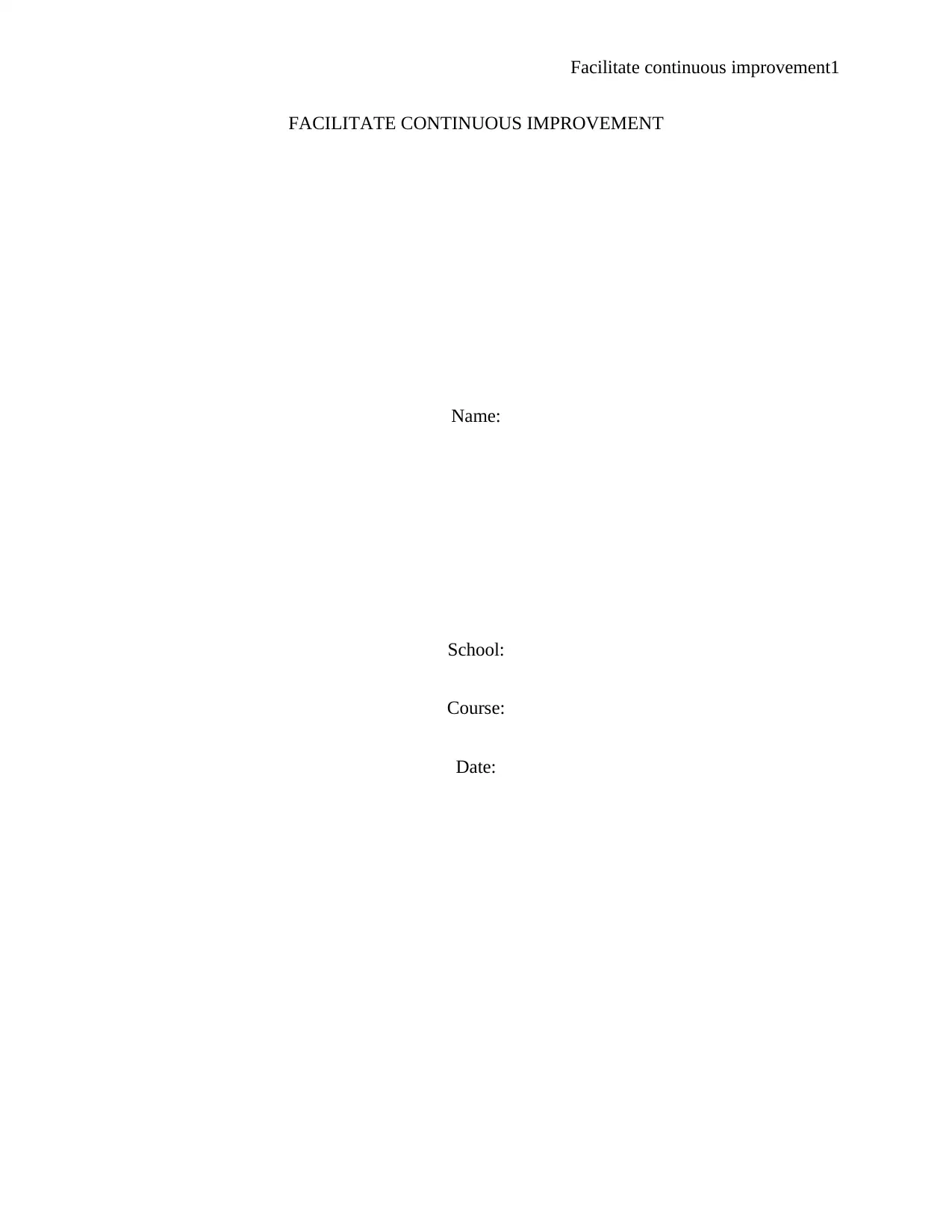
Facilitate continuous improvement1
FACILITATE CONTINUOUS IMPROVEMENT
Name:
School:
Course:
Date:
FACILITATE CONTINUOUS IMPROVEMENT
Name:
School:
Course:
Date:
Paraphrase This Document
Need a fresh take? Get an instant paraphrase of this document with our AI Paraphraser
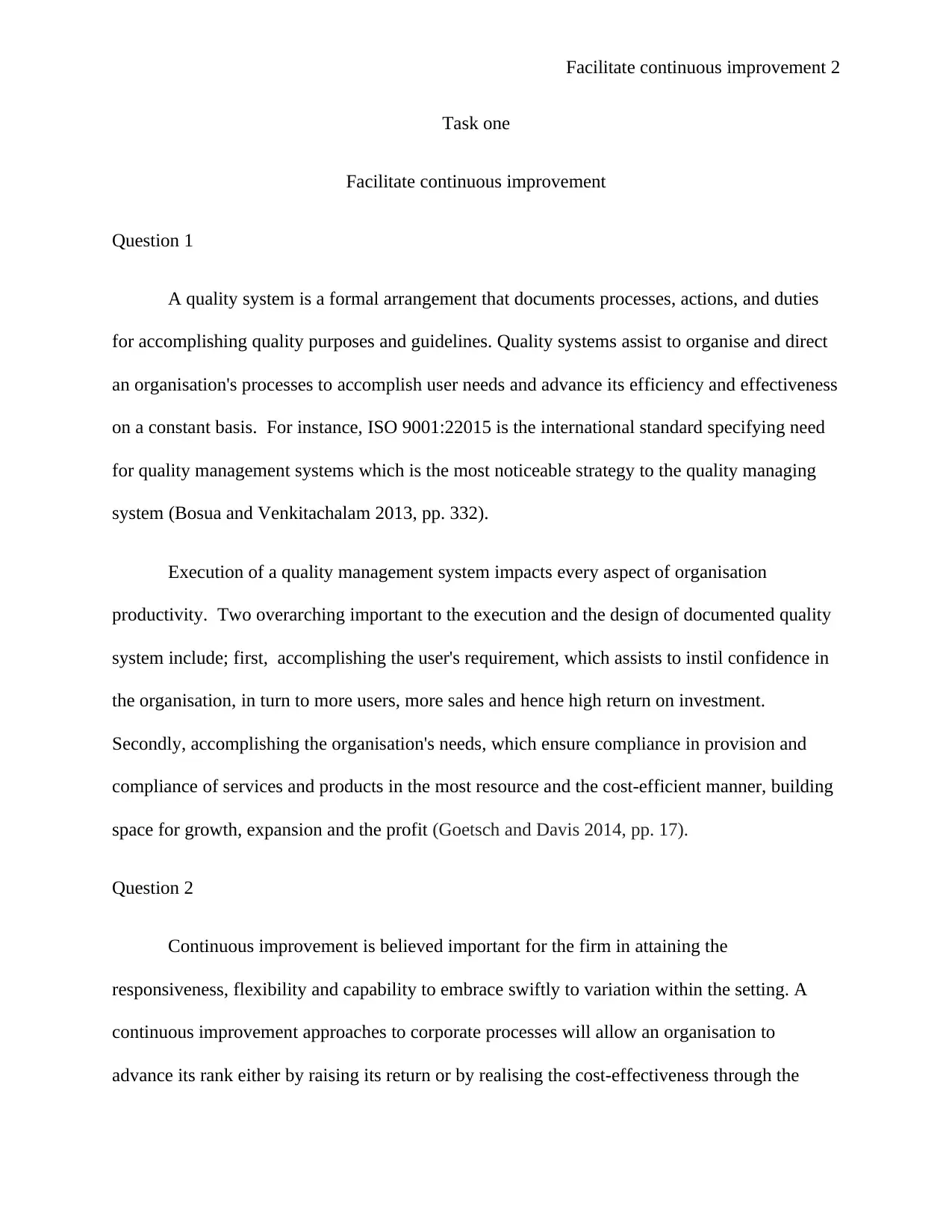
Facilitate continuous improvement 2
Task one
Facilitate continuous improvement
Question 1
A quality system is a formal arrangement that documents processes, actions, and duties
for accomplishing quality purposes and guidelines. Quality systems assist to organise and direct
an organisation's processes to accomplish user needs and advance its efficiency and effectiveness
on a constant basis. For instance, ISO 9001:22015 is the international standard specifying need
for quality management systems which is the most noticeable strategy to the quality managing
system (Bosua and Venkitachalam 2013, pp. 332).
Execution of a quality management system impacts every aspect of organisation
productivity. Two overarching important to the execution and the design of documented quality
system include; first, accomplishing the user's requirement, which assists to instil confidence in
the organisation, in turn to more users, more sales and hence high return on investment.
Secondly, accomplishing the organisation's needs, which ensure compliance in provision and
compliance of services and products in the most resource and the cost-efficient manner, building
space for growth, expansion and the profit (Goetsch and Davis 2014, pp. 17).
Question 2
Continuous improvement is believed important for the firm in attaining the
responsiveness, flexibility and capability to embrace swiftly to variation within the setting. A
continuous improvement approaches to corporate processes will allow an organisation to
advance its rank either by raising its return or by realising the cost-effectiveness through the
Task one
Facilitate continuous improvement
Question 1
A quality system is a formal arrangement that documents processes, actions, and duties
for accomplishing quality purposes and guidelines. Quality systems assist to organise and direct
an organisation's processes to accomplish user needs and advance its efficiency and effectiveness
on a constant basis. For instance, ISO 9001:22015 is the international standard specifying need
for quality management systems which is the most noticeable strategy to the quality managing
system (Bosua and Venkitachalam 2013, pp. 332).
Execution of a quality management system impacts every aspect of organisation
productivity. Two overarching important to the execution and the design of documented quality
system include; first, accomplishing the user's requirement, which assists to instil confidence in
the organisation, in turn to more users, more sales and hence high return on investment.
Secondly, accomplishing the organisation's needs, which ensure compliance in provision and
compliance of services and products in the most resource and the cost-efficient manner, building
space for growth, expansion and the profit (Goetsch and Davis 2014, pp. 17).
Question 2
Continuous improvement is believed important for the firm in attaining the
responsiveness, flexibility and capability to embrace swiftly to variation within the setting. A
continuous improvement approaches to corporate processes will allow an organisation to
advance its rank either by raising its return or by realising the cost-effectiveness through the
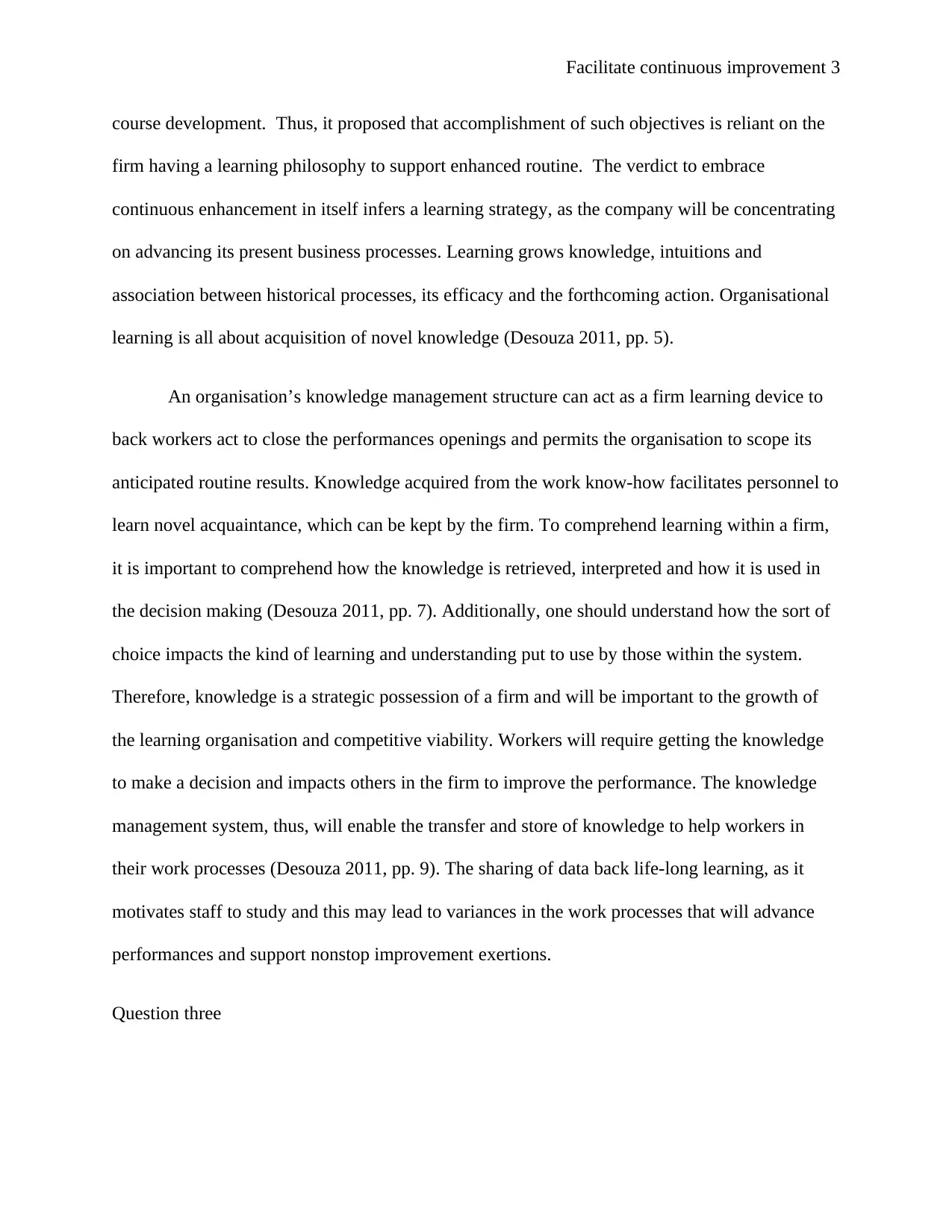
Facilitate continuous improvement 3
course development. Thus, it proposed that accomplishment of such objectives is reliant on the
firm having a learning philosophy to support enhanced routine. The verdict to embrace
continuous enhancement in itself infers a learning strategy, as the company will be concentrating
on advancing its present business processes. Learning grows knowledge, intuitions and
association between historical processes, its efficacy and the forthcoming action. Organisational
learning is all about acquisition of novel knowledge (Desouza 2011, pp. 5).
An organisation’s knowledge management structure can act as a firm learning device to
back workers act to close the performances openings and permits the organisation to scope its
anticipated routine results. Knowledge acquired from the work know-how facilitates personnel to
learn novel acquaintance, which can be kept by the firm. To comprehend learning within a firm,
it is important to comprehend how the knowledge is retrieved, interpreted and how it is used in
the decision making (Desouza 2011, pp. 7). Additionally, one should understand how the sort of
choice impacts the kind of learning and understanding put to use by those within the system.
Therefore, knowledge is a strategic possession of a firm and will be important to the growth of
the learning organisation and competitive viability. Workers will require getting the knowledge
to make a decision and impacts others in the firm to improve the performance. The knowledge
management system, thus, will enable the transfer and store of knowledge to help workers in
their work processes (Desouza 2011, pp. 9). The sharing of data back life-long learning, as it
motivates staff to study and this may lead to variances in the work processes that will advance
performances and support nonstop improvement exertions.
Question three
course development. Thus, it proposed that accomplishment of such objectives is reliant on the
firm having a learning philosophy to support enhanced routine. The verdict to embrace
continuous enhancement in itself infers a learning strategy, as the company will be concentrating
on advancing its present business processes. Learning grows knowledge, intuitions and
association between historical processes, its efficacy and the forthcoming action. Organisational
learning is all about acquisition of novel knowledge (Desouza 2011, pp. 5).
An organisation’s knowledge management structure can act as a firm learning device to
back workers act to close the performances openings and permits the organisation to scope its
anticipated routine results. Knowledge acquired from the work know-how facilitates personnel to
learn novel acquaintance, which can be kept by the firm. To comprehend learning within a firm,
it is important to comprehend how the knowledge is retrieved, interpreted and how it is used in
the decision making (Desouza 2011, pp. 7). Additionally, one should understand how the sort of
choice impacts the kind of learning and understanding put to use by those within the system.
Therefore, knowledge is a strategic possession of a firm and will be important to the growth of
the learning organisation and competitive viability. Workers will require getting the knowledge
to make a decision and impacts others in the firm to improve the performance. The knowledge
management system, thus, will enable the transfer and store of knowledge to help workers in
their work processes (Desouza 2011, pp. 9). The sharing of data back life-long learning, as it
motivates staff to study and this may lead to variances in the work processes that will advance
performances and support nonstop improvement exertions.
Question three
⊘ This is a preview!⊘
Do you want full access?
Subscribe today to unlock all pages.

Trusted by 1+ million students worldwide
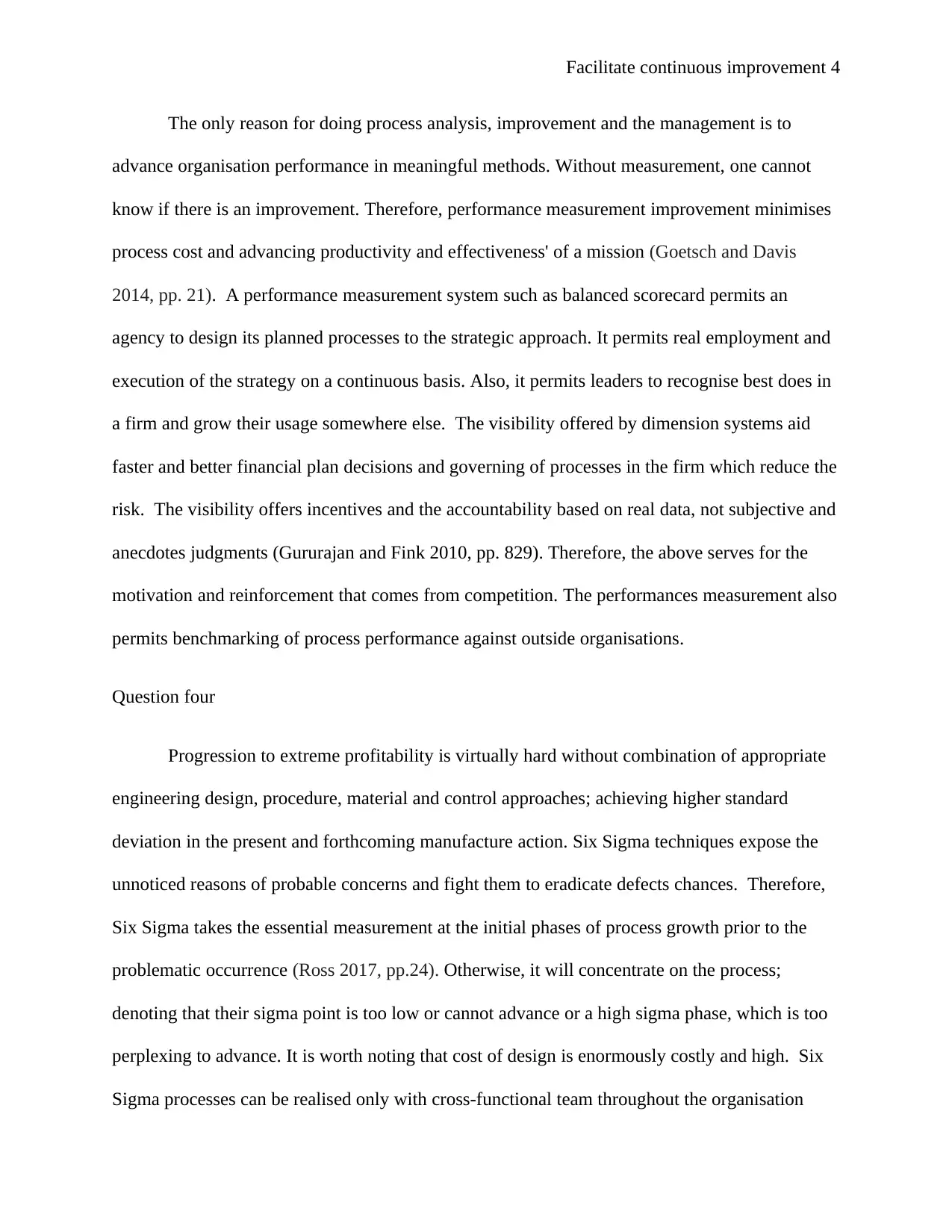
Facilitate continuous improvement 4
The only reason for doing process analysis, improvement and the management is to
advance organisation performance in meaningful methods. Without measurement, one cannot
know if there is an improvement. Therefore, performance measurement improvement minimises
process cost and advancing productivity and effectiveness' of a mission (Goetsch and Davis
2014, pp. 21). A performance measurement system such as balanced scorecard permits an
agency to design its planned processes to the strategic approach. It permits real employment and
execution of the strategy on a continuous basis. Also, it permits leaders to recognise best does in
a firm and grow their usage somewhere else. The visibility offered by dimension systems aid
faster and better financial plan decisions and governing of processes in the firm which reduce the
risk. The visibility offers incentives and the accountability based on real data, not subjective and
anecdotes judgments (Gururajan and Fink 2010, pp. 829). Therefore, the above serves for the
motivation and reinforcement that comes from competition. The performances measurement also
permits benchmarking of process performance against outside organisations.
Question four
Progression to extreme profitability is virtually hard without combination of appropriate
engineering design, procedure, material and control approaches; achieving higher standard
deviation in the present and forthcoming manufacture action. Six Sigma techniques expose the
unnoticed reasons of probable concerns and fight them to eradicate defects chances. Therefore,
Six Sigma takes the essential measurement at the initial phases of process growth prior to the
problematic occurrence (Ross 2017, pp.24). Otherwise, it will concentrate on the process;
denoting that their sigma point is too low or cannot advance or a high sigma phase, which is too
perplexing to advance. It is worth noting that cost of design is enormously costly and high. Six
Sigma processes can be realised only with cross-functional team throughout the organisation
The only reason for doing process analysis, improvement and the management is to
advance organisation performance in meaningful methods. Without measurement, one cannot
know if there is an improvement. Therefore, performance measurement improvement minimises
process cost and advancing productivity and effectiveness' of a mission (Goetsch and Davis
2014, pp. 21). A performance measurement system such as balanced scorecard permits an
agency to design its planned processes to the strategic approach. It permits real employment and
execution of the strategy on a continuous basis. Also, it permits leaders to recognise best does in
a firm and grow their usage somewhere else. The visibility offered by dimension systems aid
faster and better financial plan decisions and governing of processes in the firm which reduce the
risk. The visibility offers incentives and the accountability based on real data, not subjective and
anecdotes judgments (Gururajan and Fink 2010, pp. 829). Therefore, the above serves for the
motivation and reinforcement that comes from competition. The performances measurement also
permits benchmarking of process performance against outside organisations.
Question four
Progression to extreme profitability is virtually hard without combination of appropriate
engineering design, procedure, material and control approaches; achieving higher standard
deviation in the present and forthcoming manufacture action. Six Sigma techniques expose the
unnoticed reasons of probable concerns and fight them to eradicate defects chances. Therefore,
Six Sigma takes the essential measurement at the initial phases of process growth prior to the
problematic occurrence (Ross 2017, pp.24). Otherwise, it will concentrate on the process;
denoting that their sigma point is too low or cannot advance or a high sigma phase, which is too
perplexing to advance. It is worth noting that cost of design is enormously costly and high. Six
Sigma processes can be realised only with cross-functional team throughout the organisation
Paraphrase This Document
Need a fresh take? Get an instant paraphrase of this document with our AI Paraphraser
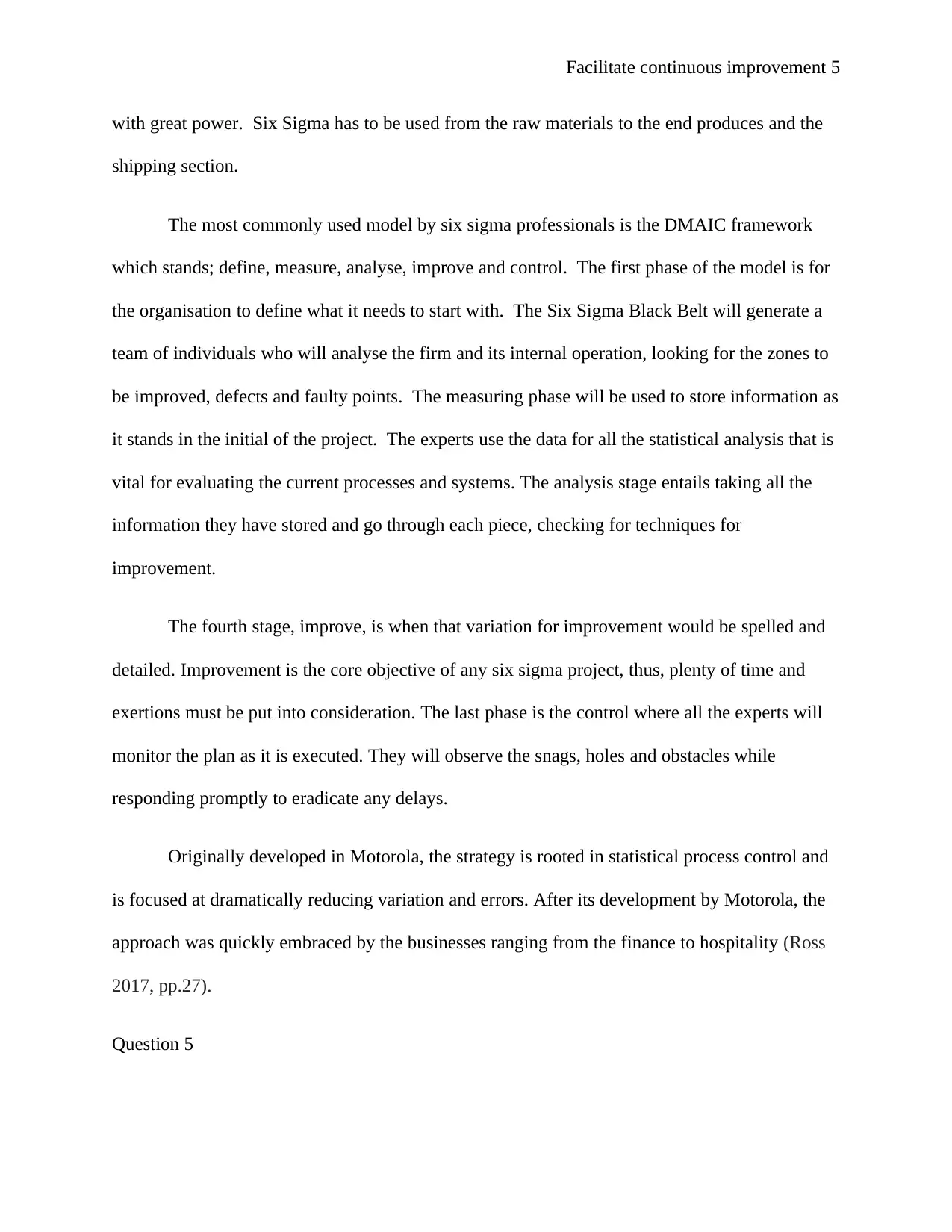
Facilitate continuous improvement 5
with great power. Six Sigma has to be used from the raw materials to the end produces and the
shipping section.
The most commonly used model by six sigma professionals is the DMAIC framework
which stands; define, measure, analyse, improve and control. The first phase of the model is for
the organisation to define what it needs to start with. The Six Sigma Black Belt will generate a
team of individuals who will analyse the firm and its internal operation, looking for the zones to
be improved, defects and faulty points. The measuring phase will be used to store information as
it stands in the initial of the project. The experts use the data for all the statistical analysis that is
vital for evaluating the current processes and systems. The analysis stage entails taking all the
information they have stored and go through each piece, checking for techniques for
improvement.
The fourth stage, improve, is when that variation for improvement would be spelled and
detailed. Improvement is the core objective of any six sigma project, thus, plenty of time and
exertions must be put into consideration. The last phase is the control where all the experts will
monitor the plan as it is executed. They will observe the snags, holes and obstacles while
responding promptly to eradicate any delays.
Originally developed in Motorola, the strategy is rooted in statistical process control and
is focused at dramatically reducing variation and errors. After its development by Motorola, the
approach was quickly embraced by the businesses ranging from the finance to hospitality (Ross
2017, pp.27).
Question 5
with great power. Six Sigma has to be used from the raw materials to the end produces and the
shipping section.
The most commonly used model by six sigma professionals is the DMAIC framework
which stands; define, measure, analyse, improve and control. The first phase of the model is for
the organisation to define what it needs to start with. The Six Sigma Black Belt will generate a
team of individuals who will analyse the firm and its internal operation, looking for the zones to
be improved, defects and faulty points. The measuring phase will be used to store information as
it stands in the initial of the project. The experts use the data for all the statistical analysis that is
vital for evaluating the current processes and systems. The analysis stage entails taking all the
information they have stored and go through each piece, checking for techniques for
improvement.
The fourth stage, improve, is when that variation for improvement would be spelled and
detailed. Improvement is the core objective of any six sigma project, thus, plenty of time and
exertions must be put into consideration. The last phase is the control where all the experts will
monitor the plan as it is executed. They will observe the snags, holes and obstacles while
responding promptly to eradicate any delays.
Originally developed in Motorola, the strategy is rooted in statistical process control and
is focused at dramatically reducing variation and errors. After its development by Motorola, the
approach was quickly embraced by the businesses ranging from the finance to hospitality (Ross
2017, pp.27).
Question 5
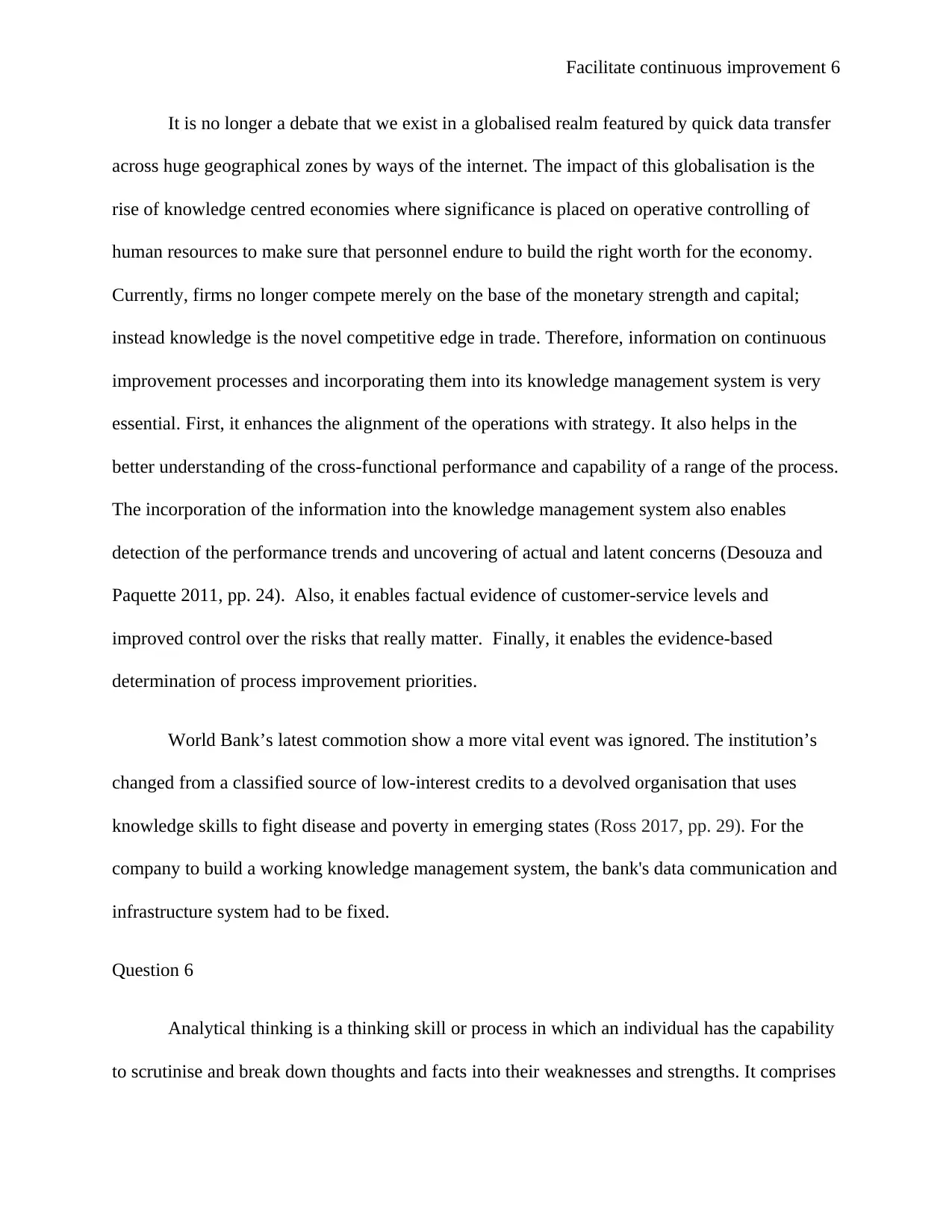
Facilitate continuous improvement 6
It is no longer a debate that we exist in a globalised realm featured by quick data transfer
across huge geographical zones by ways of the internet. The impact of this globalisation is the
rise of knowledge centred economies where significance is placed on operative controlling of
human resources to make sure that personnel endure to build the right worth for the economy.
Currently, firms no longer compete merely on the base of the monetary strength and capital;
instead knowledge is the novel competitive edge in trade. Therefore, information on continuous
improvement processes and incorporating them into its knowledge management system is very
essential. First, it enhances the alignment of the operations with strategy. It also helps in the
better understanding of the cross-functional performance and capability of a range of the process.
The incorporation of the information into the knowledge management system also enables
detection of the performance trends and uncovering of actual and latent concerns (Desouza and
Paquette 2011, pp. 24). Also, it enables factual evidence of customer-service levels and
improved control over the risks that really matter. Finally, it enables the evidence-based
determination of process improvement priorities.
World Bank’s latest commotion show a more vital event was ignored. The institution’s
changed from a classified source of low-interest credits to a devolved organisation that uses
knowledge skills to fight disease and poverty in emerging states (Ross 2017, pp. 29). For the
company to build a working knowledge management system, the bank's data communication and
infrastructure system had to be fixed.
Question 6
Analytical thinking is a thinking skill or process in which an individual has the capability
to scrutinise and break down thoughts and facts into their weaknesses and strengths. It comprises
It is no longer a debate that we exist in a globalised realm featured by quick data transfer
across huge geographical zones by ways of the internet. The impact of this globalisation is the
rise of knowledge centred economies where significance is placed on operative controlling of
human resources to make sure that personnel endure to build the right worth for the economy.
Currently, firms no longer compete merely on the base of the monetary strength and capital;
instead knowledge is the novel competitive edge in trade. Therefore, information on continuous
improvement processes and incorporating them into its knowledge management system is very
essential. First, it enhances the alignment of the operations with strategy. It also helps in the
better understanding of the cross-functional performance and capability of a range of the process.
The incorporation of the information into the knowledge management system also enables
detection of the performance trends and uncovering of actual and latent concerns (Desouza and
Paquette 2011, pp. 24). Also, it enables factual evidence of customer-service levels and
improved control over the risks that really matter. Finally, it enables the evidence-based
determination of process improvement priorities.
World Bank’s latest commotion show a more vital event was ignored. The institution’s
changed from a classified source of low-interest credits to a devolved organisation that uses
knowledge skills to fight disease and poverty in emerging states (Ross 2017, pp. 29). For the
company to build a working knowledge management system, the bank's data communication and
infrastructure system had to be fixed.
Question 6
Analytical thinking is a thinking skill or process in which an individual has the capability
to scrutinise and break down thoughts and facts into their weaknesses and strengths. It comprises
⊘ This is a preview!⊘
Do you want full access?
Subscribe today to unlock all pages.

Trusted by 1+ million students worldwide
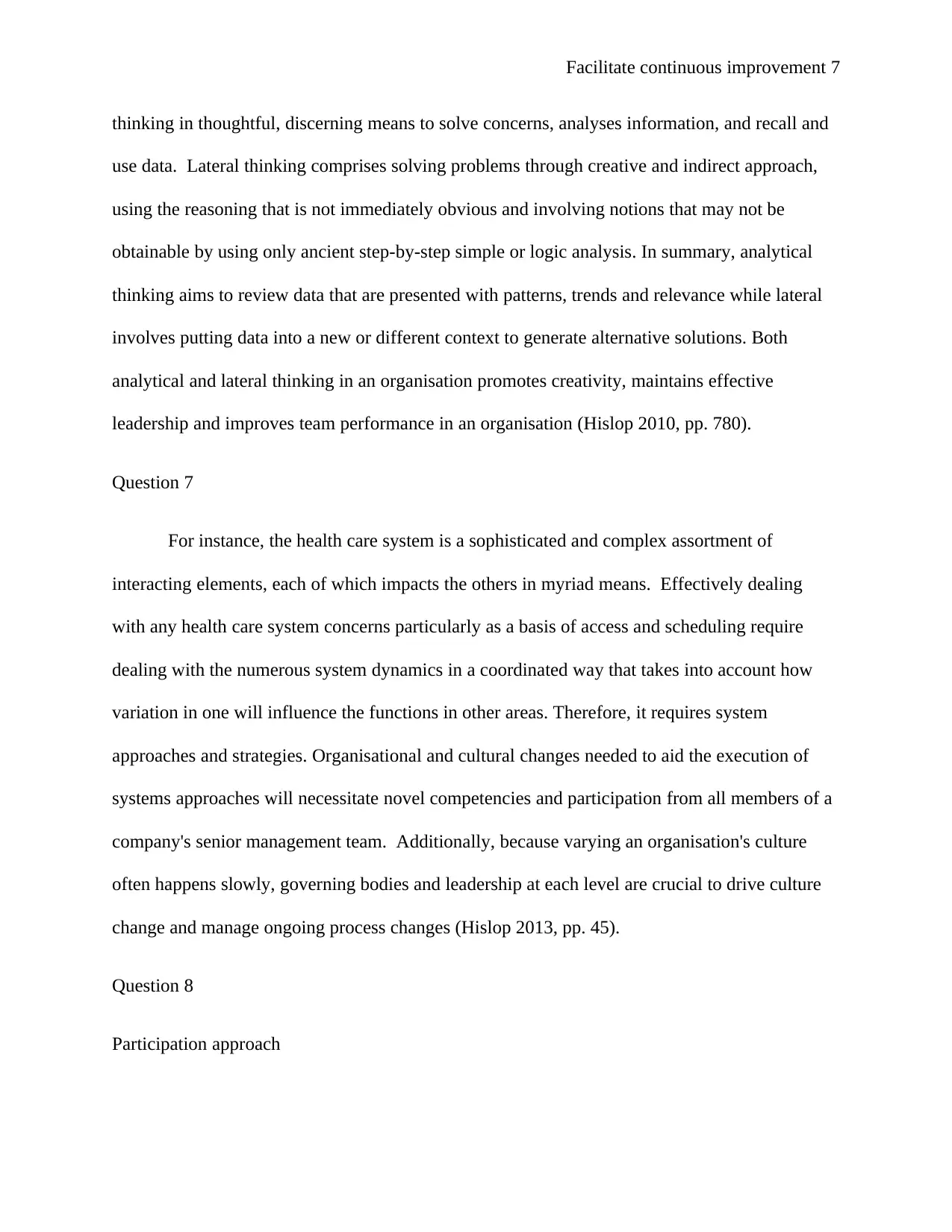
Facilitate continuous improvement 7
thinking in thoughtful, discerning means to solve concerns, analyses information, and recall and
use data. Lateral thinking comprises solving problems through creative and indirect approach,
using the reasoning that is not immediately obvious and involving notions that may not be
obtainable by using only ancient step-by-step simple or logic analysis. In summary, analytical
thinking aims to review data that are presented with patterns, trends and relevance while lateral
involves putting data into a new or different context to generate alternative solutions. Both
analytical and lateral thinking in an organisation promotes creativity, maintains effective
leadership and improves team performance in an organisation (Hislop 2010, pp. 780).
Question 7
For instance, the health care system is a sophisticated and complex assortment of
interacting elements, each of which impacts the others in myriad means. Effectively dealing
with any health care system concerns particularly as a basis of access and scheduling require
dealing with the numerous system dynamics in a coordinated way that takes into account how
variation in one will influence the functions in other areas. Therefore, it requires system
approaches and strategies. Organisational and cultural changes needed to aid the execution of
systems approaches will necessitate novel competencies and participation from all members of a
company's senior management team. Additionally, because varying an organisation's culture
often happens slowly, governing bodies and leadership at each level are crucial to drive culture
change and manage ongoing process changes (Hislop 2013, pp. 45).
Question 8
Participation approach
thinking in thoughtful, discerning means to solve concerns, analyses information, and recall and
use data. Lateral thinking comprises solving problems through creative and indirect approach,
using the reasoning that is not immediately obvious and involving notions that may not be
obtainable by using only ancient step-by-step simple or logic analysis. In summary, analytical
thinking aims to review data that are presented with patterns, trends and relevance while lateral
involves putting data into a new or different context to generate alternative solutions. Both
analytical and lateral thinking in an organisation promotes creativity, maintains effective
leadership and improves team performance in an organisation (Hislop 2010, pp. 780).
Question 7
For instance, the health care system is a sophisticated and complex assortment of
interacting elements, each of which impacts the others in myriad means. Effectively dealing
with any health care system concerns particularly as a basis of access and scheduling require
dealing with the numerous system dynamics in a coordinated way that takes into account how
variation in one will influence the functions in other areas. Therefore, it requires system
approaches and strategies. Organisational and cultural changes needed to aid the execution of
systems approaches will necessitate novel competencies and participation from all members of a
company's senior management team. Additionally, because varying an organisation's culture
often happens slowly, governing bodies and leadership at each level are crucial to drive culture
change and manage ongoing process changes (Hislop 2013, pp. 45).
Question 8
Participation approach
Paraphrase This Document
Need a fresh take? Get an instant paraphrase of this document with our AI Paraphraser
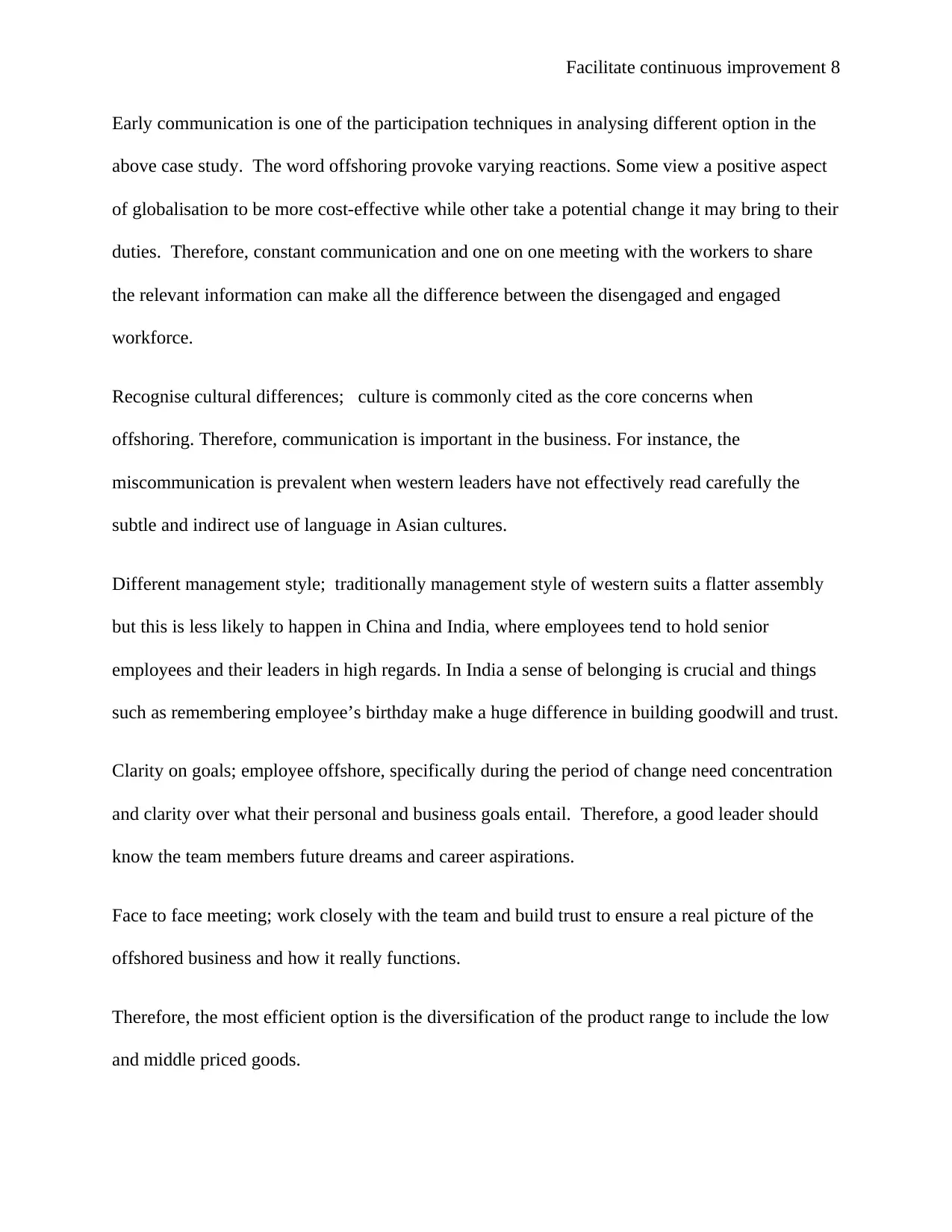
Facilitate continuous improvement 8
Early communication is one of the participation techniques in analysing different option in the
above case study. The word offshoring provoke varying reactions. Some view a positive aspect
of globalisation to be more cost-effective while other take a potential change it may bring to their
duties. Therefore, constant communication and one on one meeting with the workers to share
the relevant information can make all the difference between the disengaged and engaged
workforce.
Recognise cultural differences; culture is commonly cited as the core concerns when
offshoring. Therefore, communication is important in the business. For instance, the
miscommunication is prevalent when western leaders have not effectively read carefully the
subtle and indirect use of language in Asian cultures.
Different management style; traditionally management style of western suits a flatter assembly
but this is less likely to happen in China and India, where employees tend to hold senior
employees and their leaders in high regards. In India a sense of belonging is crucial and things
such as remembering employee’s birthday make a huge difference in building goodwill and trust.
Clarity on goals; employee offshore, specifically during the period of change need concentration
and clarity over what their personal and business goals entail. Therefore, a good leader should
know the team members future dreams and career aspirations.
Face to face meeting; work closely with the team and build trust to ensure a real picture of the
offshored business and how it really functions.
Therefore, the most efficient option is the diversification of the product range to include the low
and middle priced goods.
Early communication is one of the participation techniques in analysing different option in the
above case study. The word offshoring provoke varying reactions. Some view a positive aspect
of globalisation to be more cost-effective while other take a potential change it may bring to their
duties. Therefore, constant communication and one on one meeting with the workers to share
the relevant information can make all the difference between the disengaged and engaged
workforce.
Recognise cultural differences; culture is commonly cited as the core concerns when
offshoring. Therefore, communication is important in the business. For instance, the
miscommunication is prevalent when western leaders have not effectively read carefully the
subtle and indirect use of language in Asian cultures.
Different management style; traditionally management style of western suits a flatter assembly
but this is less likely to happen in China and India, where employees tend to hold senior
employees and their leaders in high regards. In India a sense of belonging is crucial and things
such as remembering employee’s birthday make a huge difference in building goodwill and trust.
Clarity on goals; employee offshore, specifically during the period of change need concentration
and clarity over what their personal and business goals entail. Therefore, a good leader should
know the team members future dreams and career aspirations.
Face to face meeting; work closely with the team and build trust to ensure a real picture of the
offshored business and how it really functions.
Therefore, the most efficient option is the diversification of the product range to include the low
and middle priced goods.
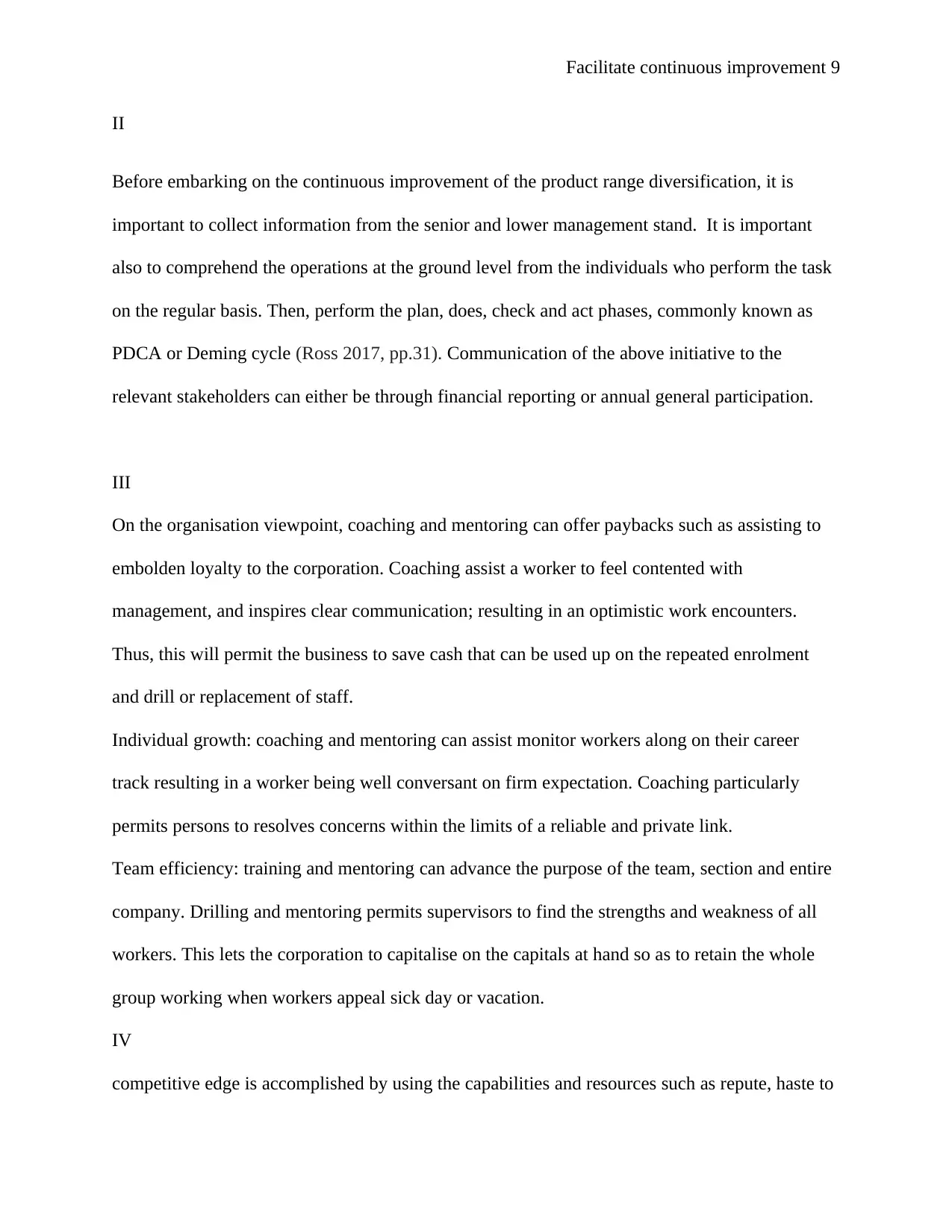
Facilitate continuous improvement 9
II
Before embarking on the continuous improvement of the product range diversification, it is
important to collect information from the senior and lower management stand. It is important
also to comprehend the operations at the ground level from the individuals who perform the task
on the regular basis. Then, perform the plan, does, check and act phases, commonly known as
PDCA or Deming cycle (Ross 2017, pp.31). Communication of the above initiative to the
relevant stakeholders can either be through financial reporting or annual general participation.
III
On the organisation viewpoint, coaching and mentoring can offer paybacks such as assisting to
embolden loyalty to the corporation. Coaching assist a worker to feel contented with
management, and inspires clear communication; resulting in an optimistic work encounters.
Thus, this will permit the business to save cash that can be used up on the repeated enrolment
and drill or replacement of staff.
Individual growth: coaching and mentoring can assist monitor workers along on their career
track resulting in a worker being well conversant on firm expectation. Coaching particularly
permits persons to resolves concerns within the limits of a reliable and private link.
Team efficiency: training and mentoring can advance the purpose of the team, section and entire
company. Drilling and mentoring permits supervisors to find the strengths and weakness of all
workers. This lets the corporation to capitalise on the capitals at hand so as to retain the whole
group working when workers appeal sick day or vacation.
IV
competitive edge is accomplished by using the capabilities and resources such as repute, haste to
II
Before embarking on the continuous improvement of the product range diversification, it is
important to collect information from the senior and lower management stand. It is important
also to comprehend the operations at the ground level from the individuals who perform the task
on the regular basis. Then, perform the plan, does, check and act phases, commonly known as
PDCA or Deming cycle (Ross 2017, pp.31). Communication of the above initiative to the
relevant stakeholders can either be through financial reporting or annual general participation.
III
On the organisation viewpoint, coaching and mentoring can offer paybacks such as assisting to
embolden loyalty to the corporation. Coaching assist a worker to feel contented with
management, and inspires clear communication; resulting in an optimistic work encounters.
Thus, this will permit the business to save cash that can be used up on the repeated enrolment
and drill or replacement of staff.
Individual growth: coaching and mentoring can assist monitor workers along on their career
track resulting in a worker being well conversant on firm expectation. Coaching particularly
permits persons to resolves concerns within the limits of a reliable and private link.
Team efficiency: training and mentoring can advance the purpose of the team, section and entire
company. Drilling and mentoring permits supervisors to find the strengths and weakness of all
workers. This lets the corporation to capitalise on the capitals at hand so as to retain the whole
group working when workers appeal sick day or vacation.
IV
competitive edge is accomplished by using the capabilities and resources such as repute, haste to
⊘ This is a preview!⊘
Do you want full access?
Subscribe today to unlock all pages.

Trusted by 1+ million students worldwide
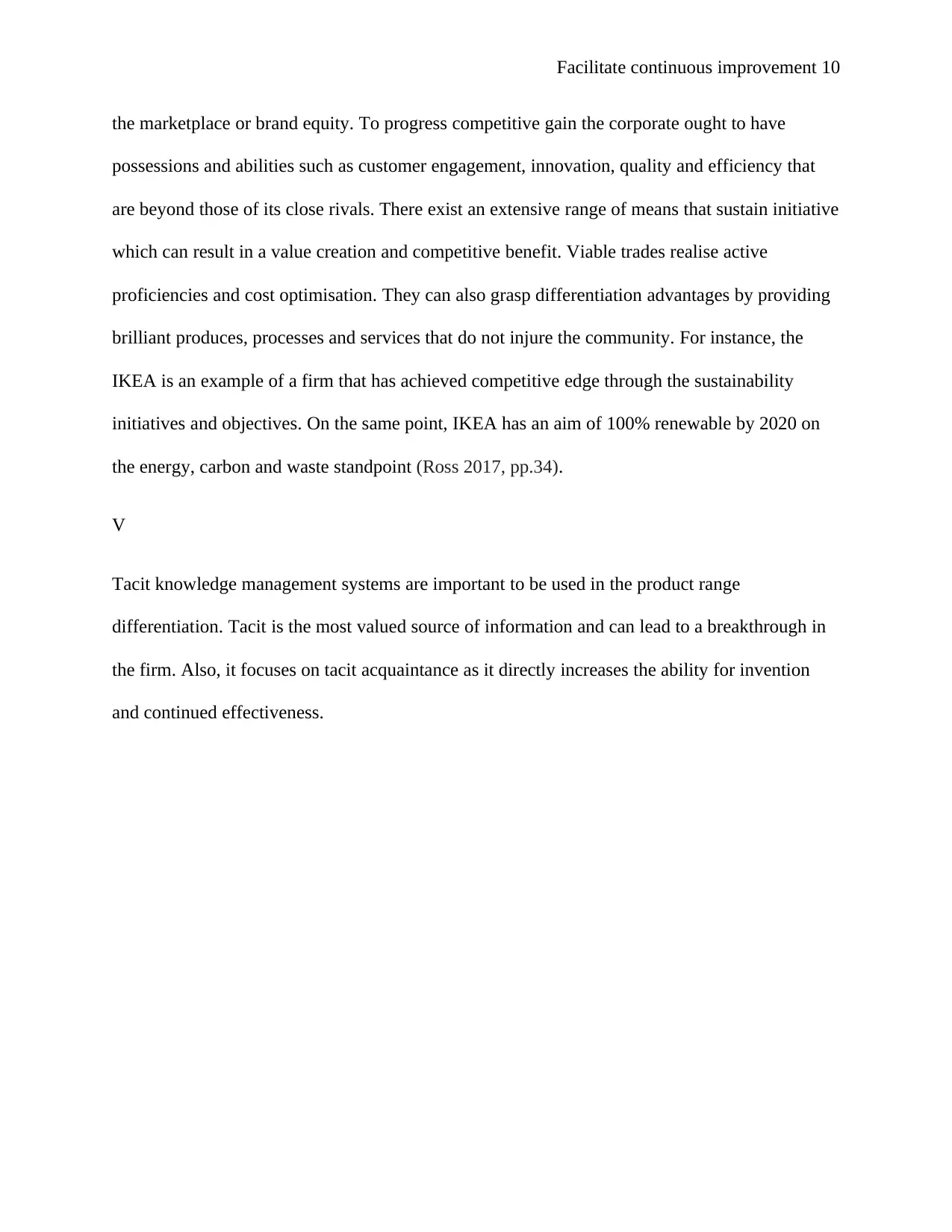
Facilitate continuous improvement 10
the marketplace or brand equity. To progress competitive gain the corporate ought to have
possessions and abilities such as customer engagement, innovation, quality and efficiency that
are beyond those of its close rivals. There exist an extensive range of means that sustain initiative
which can result in a value creation and competitive benefit. Viable trades realise active
proficiencies and cost optimisation. They can also grasp differentiation advantages by providing
brilliant produces, processes and services that do not injure the community. For instance, the
IKEA is an example of a firm that has achieved competitive edge through the sustainability
initiatives and objectives. On the same point, IKEA has an aim of 100% renewable by 2020 on
the energy, carbon and waste standpoint (Ross 2017, pp.34).
V
Tacit knowledge management systems are important to be used in the product range
differentiation. Tacit is the most valued source of information and can lead to a breakthrough in
the firm. Also, it focuses on tacit acquaintance as it directly increases the ability for invention
and continued effectiveness.
the marketplace or brand equity. To progress competitive gain the corporate ought to have
possessions and abilities such as customer engagement, innovation, quality and efficiency that
are beyond those of its close rivals. There exist an extensive range of means that sustain initiative
which can result in a value creation and competitive benefit. Viable trades realise active
proficiencies and cost optimisation. They can also grasp differentiation advantages by providing
brilliant produces, processes and services that do not injure the community. For instance, the
IKEA is an example of a firm that has achieved competitive edge through the sustainability
initiatives and objectives. On the same point, IKEA has an aim of 100% renewable by 2020 on
the energy, carbon and waste standpoint (Ross 2017, pp.34).
V
Tacit knowledge management systems are important to be used in the product range
differentiation. Tacit is the most valued source of information and can lead to a breakthrough in
the firm. Also, it focuses on tacit acquaintance as it directly increases the ability for invention
and continued effectiveness.
Paraphrase This Document
Need a fresh take? Get an instant paraphrase of this document with our AI Paraphraser
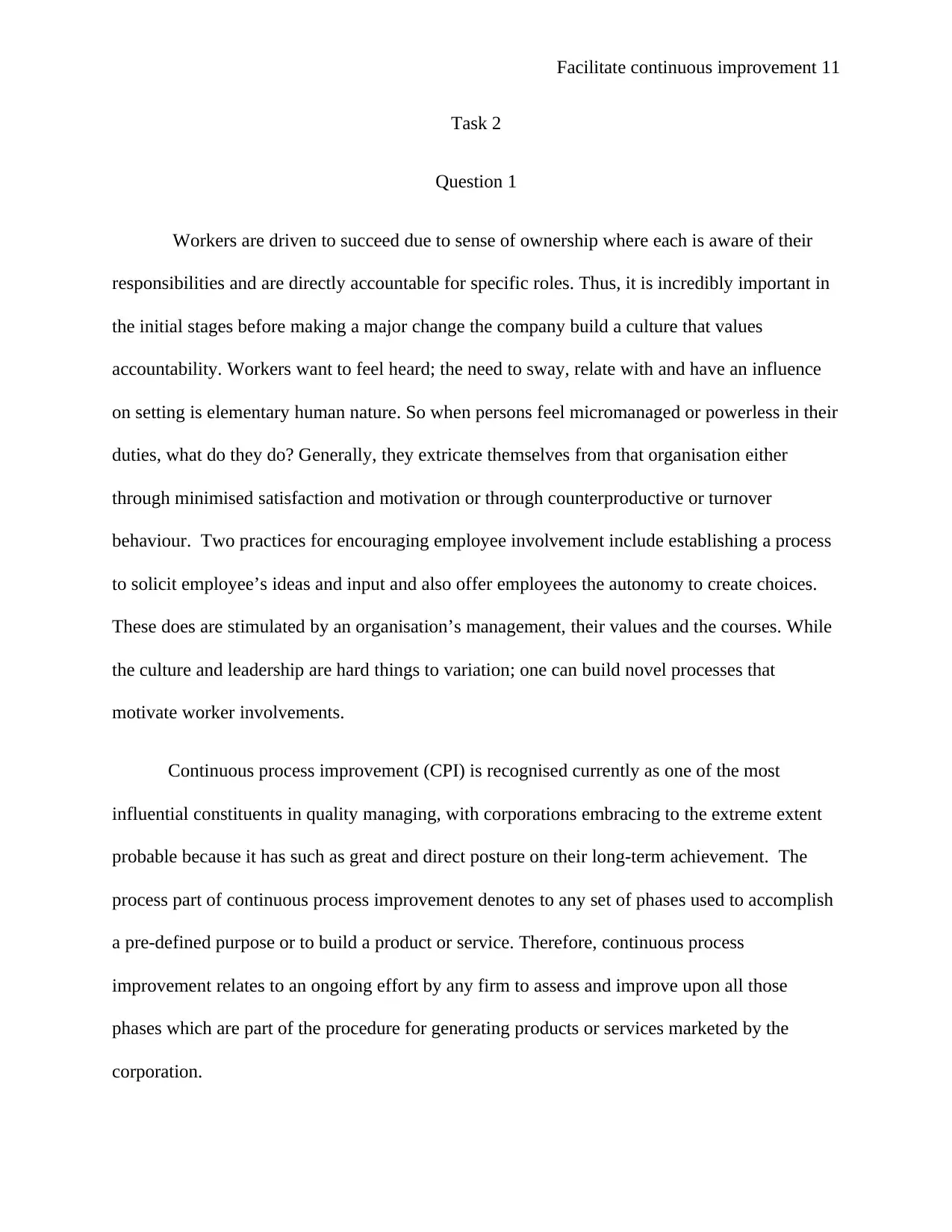
Facilitate continuous improvement 11
Task 2
Question 1
Workers are driven to succeed due to sense of ownership where each is aware of their
responsibilities and are directly accountable for specific roles. Thus, it is incredibly important in
the initial stages before making a major change the company build a culture that values
accountability. Workers want to feel heard; the need to sway, relate with and have an influence
on setting is elementary human nature. So when persons feel micromanaged or powerless in their
duties, what do they do? Generally, they extricate themselves from that organisation either
through minimised satisfaction and motivation or through counterproductive or turnover
behaviour. Two practices for encouraging employee involvement include establishing a process
to solicit employee’s ideas and input and also offer employees the autonomy to create choices.
These does are stimulated by an organisation’s management, their values and the courses. While
the culture and leadership are hard things to variation; one can build novel processes that
motivate worker involvements.
Continuous process improvement (CPI) is recognised currently as one of the most
influential constituents in quality managing, with corporations embracing to the extreme extent
probable because it has such as great and direct posture on their long-term achievement. The
process part of continuous process improvement denotes to any set of phases used to accomplish
a pre-defined purpose or to build a product or service. Therefore, continuous process
improvement relates to an ongoing effort by any firm to assess and improve upon all those
phases which are part of the procedure for generating products or services marketed by the
corporation.
Task 2
Question 1
Workers are driven to succeed due to sense of ownership where each is aware of their
responsibilities and are directly accountable for specific roles. Thus, it is incredibly important in
the initial stages before making a major change the company build a culture that values
accountability. Workers want to feel heard; the need to sway, relate with and have an influence
on setting is elementary human nature. So when persons feel micromanaged or powerless in their
duties, what do they do? Generally, they extricate themselves from that organisation either
through minimised satisfaction and motivation or through counterproductive or turnover
behaviour. Two practices for encouraging employee involvement include establishing a process
to solicit employee’s ideas and input and also offer employees the autonomy to create choices.
These does are stimulated by an organisation’s management, their values and the courses. While
the culture and leadership are hard things to variation; one can build novel processes that
motivate worker involvements.
Continuous process improvement (CPI) is recognised currently as one of the most
influential constituents in quality managing, with corporations embracing to the extreme extent
probable because it has such as great and direct posture on their long-term achievement. The
process part of continuous process improvement denotes to any set of phases used to accomplish
a pre-defined purpose or to build a product or service. Therefore, continuous process
improvement relates to an ongoing effort by any firm to assess and improve upon all those
phases which are part of the procedure for generating products or services marketed by the
corporation.
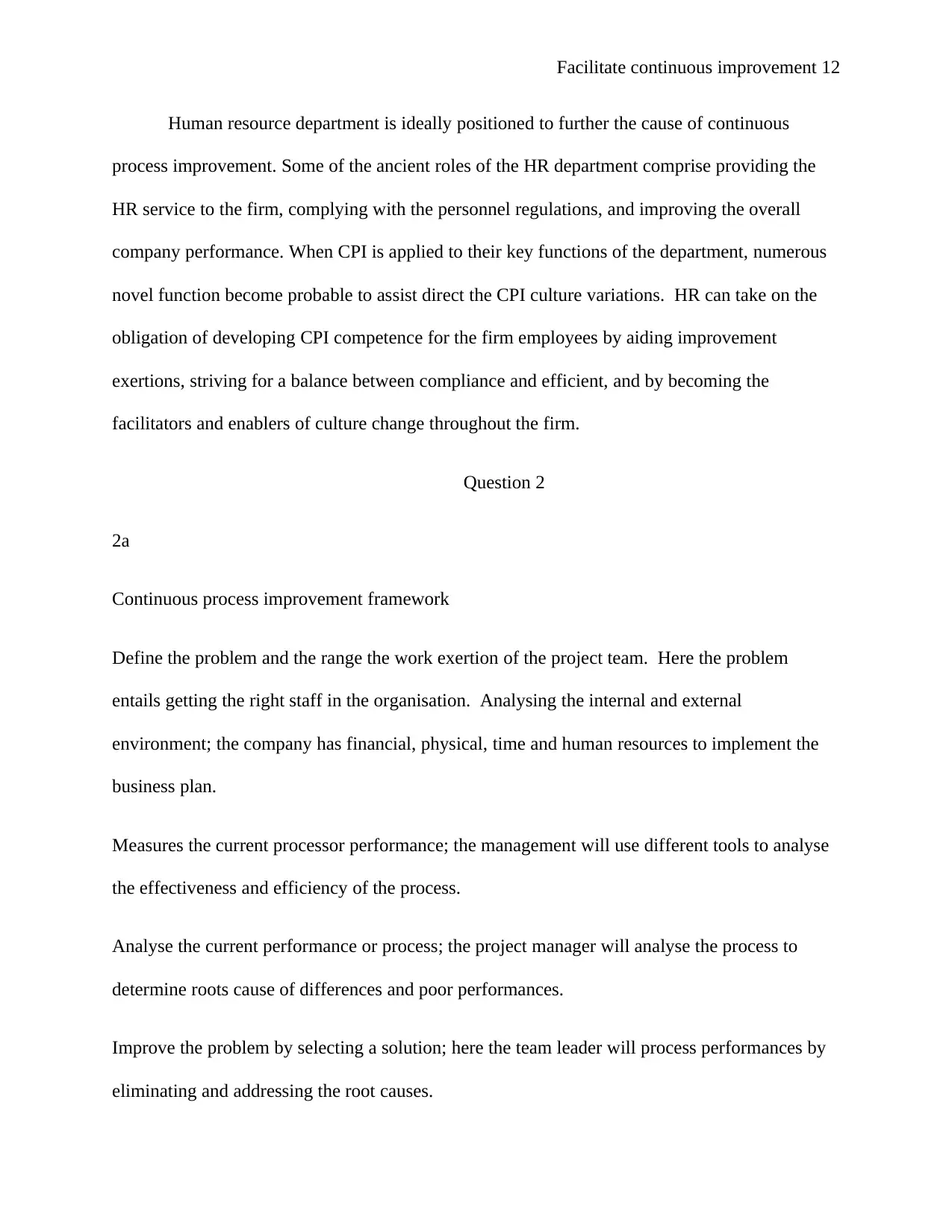
Facilitate continuous improvement 12
Human resource department is ideally positioned to further the cause of continuous
process improvement. Some of the ancient roles of the HR department comprise providing the
HR service to the firm, complying with the personnel regulations, and improving the overall
company performance. When CPI is applied to their key functions of the department, numerous
novel function become probable to assist direct the CPI culture variations. HR can take on the
obligation of developing CPI competence for the firm employees by aiding improvement
exertions, striving for a balance between compliance and efficient, and by becoming the
facilitators and enablers of culture change throughout the firm.
Question 2
2a
Continuous process improvement framework
Define the problem and the range the work exertion of the project team. Here the problem
entails getting the right staff in the organisation. Analysing the internal and external
environment; the company has financial, physical, time and human resources to implement the
business plan.
Measures the current processor performance; the management will use different tools to analyse
the effectiveness and efficiency of the process.
Analyse the current performance or process; the project manager will analyse the process to
determine roots cause of differences and poor performances.
Improve the problem by selecting a solution; here the team leader will process performances by
eliminating and addressing the root causes.
Human resource department is ideally positioned to further the cause of continuous
process improvement. Some of the ancient roles of the HR department comprise providing the
HR service to the firm, complying with the personnel regulations, and improving the overall
company performance. When CPI is applied to their key functions of the department, numerous
novel function become probable to assist direct the CPI culture variations. HR can take on the
obligation of developing CPI competence for the firm employees by aiding improvement
exertions, striving for a balance between compliance and efficient, and by becoming the
facilitators and enablers of culture change throughout the firm.
Question 2
2a
Continuous process improvement framework
Define the problem and the range the work exertion of the project team. Here the problem
entails getting the right staff in the organisation. Analysing the internal and external
environment; the company has financial, physical, time and human resources to implement the
business plan.
Measures the current processor performance; the management will use different tools to analyse
the effectiveness and efficiency of the process.
Analyse the current performance or process; the project manager will analyse the process to
determine roots cause of differences and poor performances.
Improve the problem by selecting a solution; here the team leader will process performances by
eliminating and addressing the root causes.
⊘ This is a preview!⊘
Do you want full access?
Subscribe today to unlock all pages.

Trusted by 1+ million students worldwide
1 out of 18
Related Documents
Your All-in-One AI-Powered Toolkit for Academic Success.
+13062052269
info@desklib.com
Available 24*7 on WhatsApp / Email
![[object Object]](/_next/static/media/star-bottom.7253800d.svg)
Unlock your academic potential
Copyright © 2020–2025 A2Z Services. All Rights Reserved. Developed and managed by ZUCOL.




